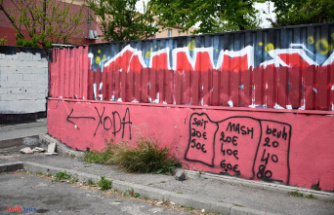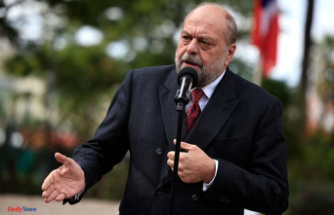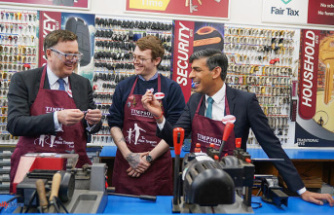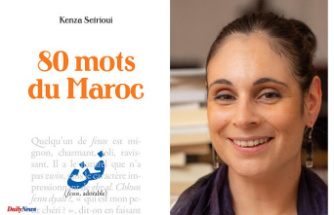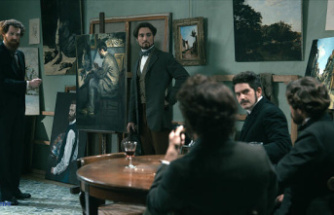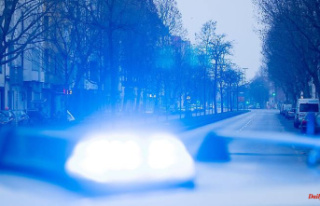Photography is celebrated and scrutinized in many places. "That makes total sense, because it's the medium that everyone uses to communicate," says Pola Sieverding. Together with Rupert Pfab she is the artistic director of the "Düsseldorf Photo Biennale for Visual and Sonic Media". The first edition suffocated in the first corona-related lockdown of spring 2020, but now the second edition can be started under the motto "Think We Must". 50 exhibitions on the subject of photography and media art can be experienced at various locations in Düsseldorf. The 41-year-old artist spoke to ntv.de about the importance of photos in the shadow of war, "seeing" as a school subject, role models and life in an artist family.
ntv.de: When does a photo become art?
Pola Sieverding: Art, including photographic art, has a lot to do with context, it has to have it.
The message of Düsseldorf Photo is "Think We Must" - we have to think. This is also the title of the exhibition in the Academy Gallery, which you curated together with Asya Yaghmurian. Why is?
Photography is indeed ubiquitous. It is important to us as a team to view images critically. That has become clear over the past two years over the pandemic. The war in Ukraine makes it clear once again how important it is to question images. The works that we show in the exhibition retell stories or refer to history. We don't see any decoration on the wall.
The Ukraine war has brought back the question of which image is true and which is propaganda. Photography can be manipulated and thus influence the present and history. Which images you see do you still believe?
In fact, I sometimes believe artistic images more than what is supposedly objective or true reporting. Artists work with photography at the interface between documentation and fiction, fundamentally questioning categories such as 'objective', 'true', 'authentic'. For the viewer it is about asking what do I see in the work of art, what do I experience in this picture about the world and about myself. Ultimately, this way of thinking in pictures creates communication.
Bullet point 'thinking in pictures' - You said elsewhere that you think through the lens. What do you mean?
By that I mean a more conscious, also critical way of seeing, because you think about the image section from the start. It is also about looking at the world through our own eyes, which is shaped by our individual socialization. In other words, about the framework that we get to see socially and as a family. It is the view of what we call reality. But if you shift your image section and thus your perspective of the world just a little bit, it looks completely different again.
A veritable flood of images washes over us every day. Do you still take photos with your cell phone camera?
Yes, I use them for notes, sometimes when setting up an exhibition. The image on the display creates a productive distance in this case and it becomes clear to me what I might still have to change. And of course my cell phone is my constant companion, as it is for all of us. For general communication and in private. It's quick to send a photo because you want to tell someone what you're doing or where you are.
Which pictures do you no longer want to see?
I'm trying to be more complex and not to say that anything that's constantly being posted is junk. More interesting than the question of what I no longer want to see is the question of how media images are dealt with and perceived. We are all producers and therefore bear responsibility for what we spread. Why doesn't sight become a school subject like reading and writing? I would say "learn to read, learn to write and learn to see".
You grew up in a family of artists, both your father Klaus Mettig and your mother Katharina Sieverding work in photography. You and your two brothers grew up surrounded by art, has that influenced your vision?
It would be presumptuous to say it didn't affect me. I believe in images and I believe in images as language, and it was sort of the language we spoke in. It was always about asking what a picture has to offer, and the dialogue about it was of course verbal. The camera was, of course, an important medium for approaching this world and getting a picture of it.
How did your mother react when you, like her, made your way into art and then also studied at the University of the Arts in Berlin, where she was a professor?
My parents took it for granted that I wanted to make art too, and they totally supported me. We are still in a very constructive but also critical exchange.
What do you talk about when you all get together as a family for dinner? One of your brothers is a DJ, the other is a carpenter...
Of all of us, he has the best idea of how to handle material (laughs). I get his advice, especially when I'm doing exhibitions. I don't know how it is in other families, but they certainly talk about work. Corona was also an issue. Especially since my DJ brother's professional platform, the clubs, had vanished into thin air. But it's also about, for example, how fantastic the food is. And again and again about politics and social issues, which my father and my mother in particular also work on artistically again and again.
Is your mother a role model for you?
Yes, although I can actually say that my parents are both role models for me. Of course, I understand why it's always about the mother in the public eye, I think it's okay and right. She is one of the few representatives of this whole German, male-dominated post-war artist community. She claimed exactly that, not having to trade one for the other - she was a mother and continued to work as an artist. Why did that work? Because I have a father and they were both very avant-garde.
Can art change anything?
Yes, otherwise I wouldn't do it. Also not a project like the Düsseldorf Photo. Society is unthinkable without cultural production. In these two years of the pandemic, in which culture was not considered systemically important and did not take place, you could get a glimpse of where we are going.
What do you personally enjoy about this project and about photography in general?
In fact, the relationships you build. To the people who place so much trust in you that they end up lending me their picture. Photography not in the sense of social media, but as a social medium.
Juliane Rohr spoke with Pola Sieverding. All information about the Düsseldorf Photo Biennale for Visual and Sonic Media can be found here. The exhibition "Think we must" runs until June 19 in the Academy Gallery "Die Neue Sammlung", Burgplatz 1, 40213 Dusseldorf


